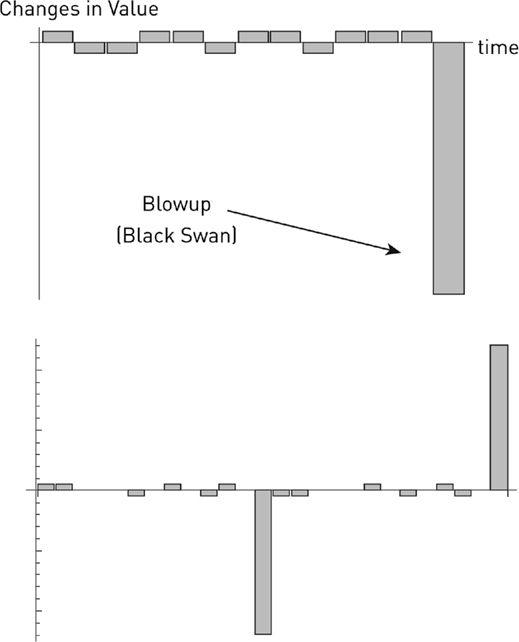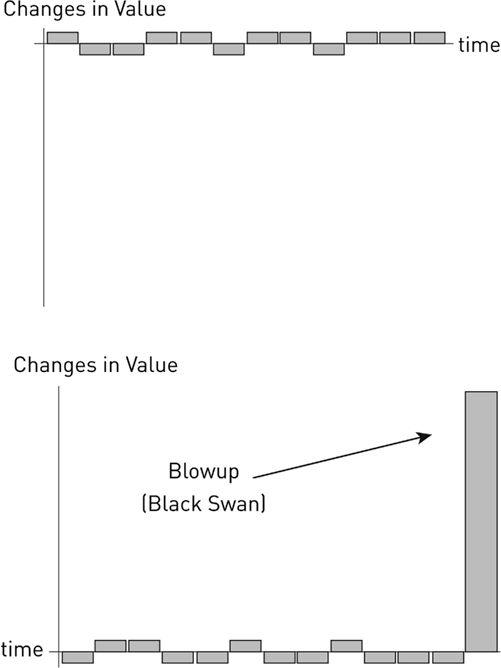Antifragile: Things That Gain from Disorder (80 page)
Read Antifragile: Things That Gain from Disorder Online
Authors: Nassim Nicholas Taleb

Non-narrative action
: Does not depend on a narrative for the action to be right—the narrative is just there to motivate, entertain, or prompt action. See
flâneur.
Robust Narrative
: When the narrative does not produce opposite conclusions or recommendations for action under change of assumption or environment. The narrative is otherwise fragile. Similarly, a robust model or mathematical tool does not lead to different policies when you change some parts of the model.
Subtractive Knowledge
: You know what is wrong with more certainty than you know anything else. An application of
via negativa.
Via negativa:
In theology and philosophy, the focus on what something is not, an indirect definition. In action, it is a recipe for what to avoid, what not to do—subtraction, not addition, say, in medicine.
Subtractive Prophecy
: Predicting the future by removing what is fragile from it rather than naively adding to it. An application of
via negativa.
Lindy Effect
: A technology, or anything nonperishable, increases in life expectancy with every day of its life—unlike perishable items (such as humans, cats, dogs, and tomatoes). So a book that has been a hundred years in print is likely to stay in print another hundred years.
Neomania
: A love of change for its own sake, a form of philistinism that does not comply with the
Lindy effect
and understands fragility. Forecasts the future by adding, not subtracting.
Opacity
: You do not see the barrel when someone is playing Russian roulette. More generally, some things remain opaque to us, leading to illusions of understanding.
Mediocristan
: A process dominated by the mediocre, with few extreme successes or failures (say, income for a dentist). No single observation can meaningfully affect the aggregate. Also called “thin-tailed,” or member of the Gaussian family of distributions.
Extremistan
: A process where the total can be conceivably impacted by a single observation (say, income for a writer). Also called “fat-tailed.” Includes the fractal, or power-law, family of distributions.
Nonlinearities, Convexity Effects (smiles and frowns)
: Nonlinearities can be concave or convex, or a mix of both. The term
convexity effects
is an extension and generalization of the fundamental asymmetry. The technical name for fragility is negative convexity effects and for antifragility is positive convexity effects. Convex is good (a smiley), concave is bad (a frowny).
Philosopher’s Stone
, also called
Convexity Bias
(very technical): The exact measure of benefits derived from nonlinearity or optionality (or, even more technically, the difference between
x
and a convex function of
x
). For instance, such bias can quantify the health benefits of variable intensity of pulmonary ventilation over steady pressure, or compute the gains from infrequent feeding. The
Procrustean bed
from the neglect of nonlinearity (to “simplify”) lies in assuming such convexity bias does not exist.
A GRAPHICAL TOUR OF THE BOOK
For those nonliterary folks who like to see things in graphs, rather than words, and those only.
FIGURE 19
.
This graph explains both the nonlinear response and the “less is more” idea. As the dose increases beyond a certain point, benefits reverse. We saw that everything nonlinear is either convex, concave, or, as in this graph, mixed. Also shows how under nonlinearities, reductions fail: the Procrustean bed of words “good for you” or “bad” is severely distorting.
Also shows why tinkering-derived heuristics matter because they don’t take you into the danger zone—words and narratives do. Note how the “more is more” zone is convex, meaning accelerated initial benefits. (In Levantine Arabic, the zone beyond the saturation has a name: “more of it is like less of it.”)
“more of it is like less of it.”)
Finally, it shows why competitive “sophistication” (rather, complication masked as sophistication) is harmful, as compared to the practitioner’s craving for optimal simplicity.
Fragility Transfer Theorem:
Note that by the Fragility Transfer Theorem,
(volatility and other members of the disorder cluster), and
CONCAVE EXPOSURE ↔ DISLIKES VOLATILITY
FIGURE 20
.
Fragile variations through time, two types of fragilities.
A representative series. The horizontal axis shows time, the vertical one shows variations. This can apply to anything: a health indicator, changes in wealth, your happiness, etc. We can see small (or no) benefits and variations most of the time and occasional large adverse outcomes. Uncertainty can hit in a rather hard way. Notice that the loss can occur at any time and exceed the previous cumulative gains. Type 2 (top) and Type 1 (bottom) differ in that Type 2 does not experience large positive effects from uncertainty while Type 1 does.
FIGURE 21
.
The Just Robust
(but not antifragile) (top): It experiences small or no variations through time. Never large ones.
The Antifragile
system (bottom): Uncertainty benefits a lot more than it hurts—the exact opposite of the first graph in
Figure 20
.
FIGURE 22
.
The horizontal axis represents outcomes, the vertical their probability (i.e., their frequency).
The Robust:
Small positive and negative outcomes.
The Fragile
(
Type 1
, very rare): Can deliver both large negative and large positive outcomes. Why is it rare? Symmetry is very, very rare empirically yet all statistical distributions tend to simplify by using it.
The Fragile (Type 2):
We see large improbable downside (often hidden and ignored), small upside. There is a possibility of a severe unfavorable outcome (left), much more than a hugely favorable one, as the left side is thicker than the right one.
The Antifragile:
Large upside, small downside. Large favorable outcomes are possible, large unfavorable ones less so (if not impossible). The right “tail,” for favorable outcomes, is larger than the left one.








